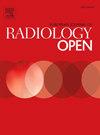基于放射组学的机器学习在对比增强 CT 上鉴别诊断肾小肿瘤细胞瘤和透明细胞癌中的作用:一项试点研究
IF 2.9
Q3 RADIOLOGY, NUCLEAR MEDICINE & MEDICAL IMAGING
引用次数: 0
摘要
目的 研究基于放射组学的机器学习在对比增强 CT(CECT)上区分肾小肿瘤(RO)和透明细胞癌(ccRCC)的潜在作用。病理检查结果显示,39 例为ccRCC,13 例为RO。所有病变均由人工划定未增强期(B)、动脉期(A)和静脉期(V)。采用 25 HU、10 HU 和 5 HU 三种不同的固定分档宽度(bw)提取每个阶段(B、A、V)的放射组学特征,并采用不同的组合(B+A、B+V、B+A+V、A+V),最终得到 21 个不同的数据集。蒙特卡洛交叉验证技术用于量化估计器的性能。使用 Optuna 选定的超参数建立的最终模型在训练集上再次进行训练,并在测试集上进行最终性能评估。结果考虑到所有模型,A+V bw 10 获得了更高的中位数(IQR)平衡精度 0.70(0.64-0.75),而 A bw 10 仅考虑了单相模型。A bw 10 模型的灵敏度中位数(IQR)为 0.60(0.40-0.60),特异性为 0.80(0.73-0.87),AUC-ROC 为 0.77(0.66-0.84),准确度为 0.75(0.70-0.80),Phi 系数为 0.38(0.20-0.47)。结论A bw 10模型被认为是区分小RO和ccRCC最有效的单相模型。本文章由计算机程序翻译,如有差异,请以英文原文为准。
Radiomics-based machine learning role in differential diagnosis between small renal oncocytoma and clear cells carcinoma on contrast-enhanced CT: A pilot study
Purpose
To investigate the potential role of radiomics-based machine learning in differentiating small renal oncocytoma (RO) from clear cells carcinoma (ccRCC) on contrast-enhanced CT (CECT).
Material and methods
Fifty-two patients with small renal masses who underwent CECT before surgery between January 2016 and December 2020 were retrospectively included in the study. At pathology examination 39 ccRCC and 13 RO were identified. All lesions were manually delineated unenhanced (B), arterial (A) and venous (V) phases. Radiomics features were extracted using three different fixed bin widths (bw) of 25 HU, 10 HU, and 5 HU from each phase (B, A, V), and with different combinations (B+A, B+V, B+A+V, A+V), leading to 21 different datasets. Montecarlo Cross Validation technique was used to quantify the estimator performance. The final model built using the hyperparameter selected with Optuna was trained again on the training set and the final performance evaluation was made on the test set.
Results
The A+V bw 10 achieved the greater median (IQR) balanced accuracy considering all the models of 0.70 (0.64–0.75), while A bw 10 considering only the monophasic ones. The A bw 10 model achieved a median (IQR) sensitivity of 0.60 (0.40–0.60), specificity of 0.80 (0.73–0.87), AUC-ROC of 0.77 (0.66–0.84), accuracy of 0.75 (0.70–0.80), and a Phi Coefficient of 0.38 (0.20–0.47). None of the nine models with the lowest mean balanced accuracy values implemented features from A.
Conclusion
The A bw 10 model was identified as the most efficient mono-phasic model in differentiating small RO from ccRCC.
求助全文
通过发布文献求助,成功后即可免费获取论文全文。
去求助
来源期刊

European Journal of Radiology Open
Medicine-Radiology, Nuclear Medicine and Imaging
CiteScore
4.10
自引率
5.00%
发文量
55
审稿时长
51 days
 求助内容:
求助内容: 应助结果提醒方式:
应助结果提醒方式:


